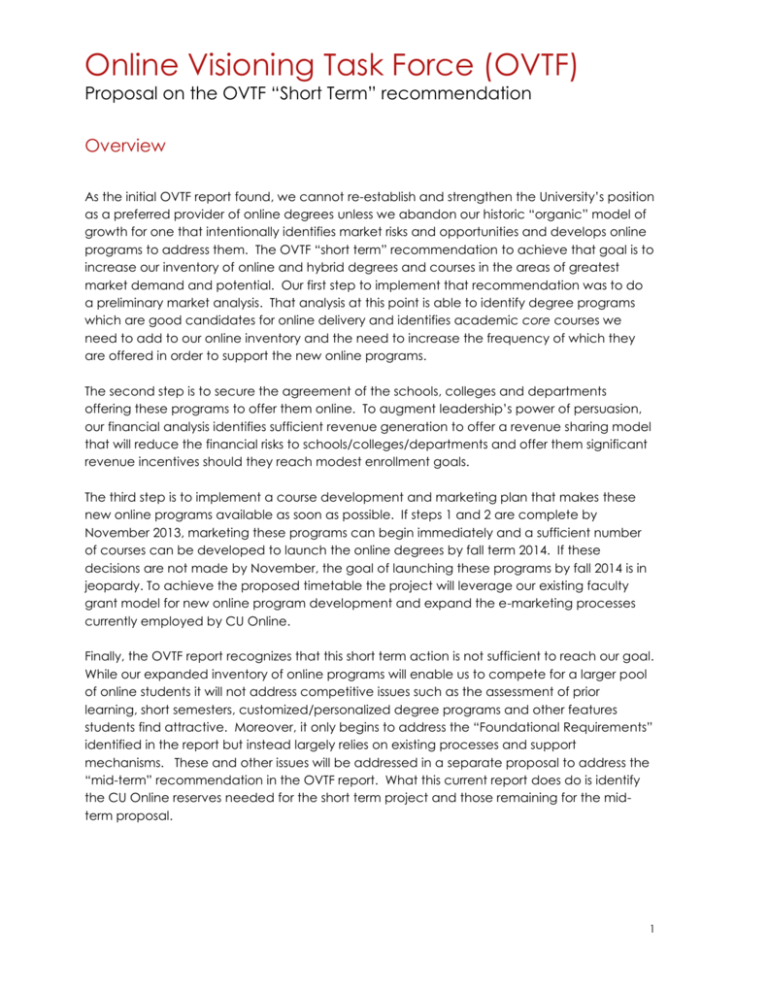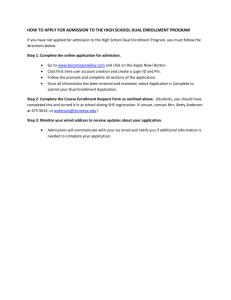Online Visioning Task Force (OVTF)
advertisement

Online Visioning Task Force (OVTF) Proposal on the OVTF “Short Term” recommendation Overview As the initial OVTF report found, we cannot re-establish and strengthen the University’s position as a preferred provider of online degrees unless we abandon our historic “organic” model of growth for one that intentionally identifies market risks and opportunities and develops online programs to address them. The OVTF “short term” recommendation to achieve that goal is to increase our inventory of online and hybrid degrees and courses in the areas of greatest market demand and potential. Our first step to implement that recommendation was to do a preliminary market analysis. That analysis at this point is able to identify degree programs which are good candidates for online delivery and identifies academic core courses we need to add to our online inventory and the need to increase the frequency of which they are offered in order to support the new online programs. The second step is to secure the agreement of the schools, colleges and departments offering these programs to offer them online. To augment leadership’s power of persuasion, our financial analysis identifies sufficient revenue generation to offer a revenue sharing model that will reduce the financial risks to schools/colleges/departments and offer them significant revenue incentives should they reach modest enrollment goals. The third step is to implement a course development and marketing plan that makes these new online programs available as soon as possible. If steps 1 and 2 are complete by November 2013, marketing these programs can begin immediately and a sufficient number of courses can be developed to launch the online degrees by fall term 2014. If these decisions are not made by November, the goal of launching these programs by fall 2014 is in jeopardy. To achieve the proposed timetable the project will leverage our existing faculty grant model for new online program development and expand the e-marketing processes currently employed by CU Online. Finally, the OVTF report recognizes that this short term action is not sufficient to reach our goal. While our expanded inventory of online programs will enable us to compete for a larger pool of online students it will not address competitive issues such as the assessment of prior learning, short semesters, customized/personalized degree programs and other features students find attractive. Moreover, it only begins to address the “Foundational Requirements” identified in the report but instead largely relies on existing processes and support mechanisms. These and other issues will be addressed in a separate proposal to address the “mid-term” recommendation in the OVTF report. What this current report does do is identify the CU Online reserves needed for the short term project and those remaining for the midterm proposal. 1 Market Analysis Summary To meet short-term demands for online program growth, we have identified the following candidate programs. The criteria for selecting programs to pursue is:’ 1. Program must be a currently approved degree program. The online program will overlay a current program. As a result, no action by the Board of Regents or HLC is required. 2. Select programs with demonstrated local demand. Current programs with large enrollments point to a level of local demand that online delivery can tap into and expand.. 3. Select programs with strong national demand and/or growth. While most online students are likely to come from within the state, demonstrated strong national demand is another indicator of likely online curriculum demand. 4. Current course online. Programs with online inventory can leverage these courses and online delivery expertise. 5. Overall fitness. Is the program a good fit for online? On indication of fitness are the number of competing programs already in the space. Another are intangibles such as faculty willingness, perceived complexity of putting the program online or other environmental factors. For instance, there is a perception that teaching lab science online is a barrier. 6. Lack of competition. While the space for online programs grown increasingly more crowded, there are opportunities for “first movers” in high enrollment, but few online programs areas such as biology The following table summarizes the top candidates for short-term online program overlays. 2 Undergraduate Online Program Opportunity Matrix Program UCD rank by major UCD Major s UCD enrollment trend 2009-11 degrees, US Current courses online Student requests Competitors3 Biology 1 1 1016 + 10% +4.28% 4U 15 Psychology Economics Communications Business Admin2 Accounting Management Finance Marketing Public Health Civil engineering 2 4 7 663 396 337 808 247 213 174 174 197 115 -10% +19% -8% +3.78% +3.22% +2.42% +36.03 -3.82% 4U 5U 7U, 1G 30 0 15 W (Biological science); R (applied science) C; P; M; (Boulder [pending) P R; G; D; M -3.18% -3.45% +41% +10.98% 8U,11G 1. 2. 3. 10 12 17 18 14 33 -12% -27% -17% -12% +1482% +4% 6U, 6G 6 15 10 A; R; G; W; M A; R; G; W; P; M R; M A; R; G; W; M None None Biology may be a candidate for a hybrid model that may or may not be appropriate for Phase I Business Administration has a variety of emphases that students can take. Those with the largest # at CU Denver are listed. Competitors Key: A=Adams State, C=CSU Online+, D=DU, G=CSU Global, M=University of Maryland, P=Penn State World Campus, R=Regis, W=Western Governors 3 Criteria 1 dictates that we look at currently available programs. However, based on national trends, there are a number of potential degree areas In which we already have expertise, that could presumably be proposed over a slight longer, but still nearterm, timeline. The follow table highlights some of these opportunities Other Undergraduate Online Program Opportunities Program 2009 -11 Notes degrees US Interdisciplinary +12.17% We currently have an individually structure major in 1 studies CLAS. But this degree is not entirely equivalent to a general studies degree, or interdisciplinary studies degree. This degree is widely available from competitors. Health care +18.43% admin/management Information + 23.36% We have an “emphasis” in information systems technology available in our Business Admin degree. 4 Financial Analysis Summary 1. The attached financial analysis models creation of an online degree in Psychology and shows significant net revenue results from a conservative estimate of enrollment. This is true even at the 36% GAR rate. Since Finance and Administration has already determined that increases in enrollment are generally net revenue positive, and that has been a guiding principle in our campus strategy, this outcome was not unexpected. The financial model can be used to look at other potential online degree programs by adjusting the variables such as the number of new courses needed for the respective degrees and anticipated enrollment. 2. There are no known additional facility or infrastructure costs for offering online programs apart from additional faculty and staff offices should expansion increase beyond the elasticity in our current usage. Online students do not require campus facilities and services such as police, and do pay for technology infrastructure costs through their technology fees. Moreover, as of July 2013, online students now pay the student services fee and provide financial support for delivering student services online. This is an important strategic goal for the campus as a whole since the provision of online services has been shown to be a mark of institutional quality for both campus and online students. These facility and infrastructure cost savings may be persuasive in arguing for a lower GAR rate on revenue from these online courses as is the case with extended studies revenue. 3. Rather than replace current curriculum, phase I simply adds online delivery options of current curriculum in order to increase the availability of online degree achievement. As a result, targeted programs will expand through an emphasis on alternative deliver models, not disruption of curriculum. The means targeted programs and courses can reach enrollment targets through incremental staff growth. This includes hiring new adjunct and full-time instructors as well as encouraging current tenure-line faculty to teach no more than one online course a year. This is an important point because it emphasizes faculty control of course and curriculum while providing incentives and support to expand delivery options. 4. All costs for developing and supporting new online courses are paid entirely from online student fees. Plant fund fee reserves are more than adequate to cover any anticipated scale of new online program development. Online fees currently cover all ongoing operational costs except for advertising (not a permitted use of fees) and the budget model shows that even the reserves spent to launch the new programs can be replenished over time by additional fees collected through online enrollment growth. CU Online operations have historically been able to create program development reserves by keeping expenses below costs, especially during periods of enrollment growth where revenue grew faster than expenses. CU Online will generate a surplus again this year and after the Blackboard and eCollege contracts expire in June and July respectively, considerably more revenue will be available to invest even if enrollment remains flat. CU Online does not have budget for FY15 yet but anticipates up to $400,000 5 per year in surplus revenue will be generated that year at current enrollment rates. The budget for this project does not rely on any of that future revenue. The intent is to use that revenue, as well as additional reserves, to fund the 2nd “intermediate term” recommendation from OVTF. In other words, the expenditures in this budget do not jeopardize our ability to fund the next phase of the OVTF recommendations. Current CU Online Plant Fund reserves: One-time expenses for “short-term” project (8 new degrees) Reserves left available for the “mid-term” OVTF project $1,101,212 -$500,000 $601,212 5. Advertising costs will depend on the number of degrees offered and the number of students you need to recruit. Average national costs for recruiting undergraduates range from $500 - $2000. Our budget identifies $30,000 per online degree in initial launch cost plus $500 x the number of new students needed. CU Online has an experienced marketing team that can help place, manage and track advertising activities, as well as the infrastructure to evaluate and optimize where programs should be advertising (email, social, ad words, banner ads, etc...). To assure schools/colleges and departments that advertising costs will be covered in the future, it is advisable to consider earmarking a percentage of revenue for advertising in any proposed revenue sharing model. 6. Cannibalization rate. This term refers to students who are on campus deciding to take their courses online when that option is available to them. This does not result in a decline in tuition revenue or costs if instruction on campus is reduced and added to online commensurate with the scope of cannibalization. It is important, however, if a greater proportion of the tuition revenue in online classes goes to the schools/colleges/departments than is the case under the existing model. Cannibalization in this case would result in greater revenue for the units and less for central administration. It is uncertain what the cannibalization rate will be, although some is anticipated. Nor is cannibalization entirely bad, because at least students are staying at CU Denver instead of going to another online program because the University doesn’t have one they need. This defensive financial rationale should not be underestimated, especially in cases, such as psychology, where the number of degrees awarded nationally is increasing but our enrollments are decreasing and the possibility that other institutions are cannibalizing our students is real. CSU Online Plus, for example, just started offering an online psychology degree this past year and they are actively recruiting in the Denver area. There is some indirect evidence to estimate cannibalization rates. In a national study of online students approximately 30% of them said they also had considered on-campus programs and so it is likely that the existence of online programs does have some effect on campus enrollment. Perhaps our best evidence comes from what happened when the BACJ degree began to be offered online this fall. Enrollment in campus sections of BACJ declined from 271 to 257 (5%). However, enrollment in online sections grew from 71 to 223 (314%). Combined campus and online enrollment increased by 139 (41%). Furthermore, applications for the degree increased from 153 to 225 (47%). If these numbers hold for other degree programs it is clear that the risk of cannibalization is far exceeded by the opportunities for enrollment growth. 6 7. Revenue Sharing Many institutions with highly selective admissions and nationally ranked programs as well as many of our aspirational peers, have determined that there are no longer pedagogical obstacles to offering many of their programs online and have decided to do so. Given the national acceptance of online programs and our own experience the OVTF recommended that our institution make decisions about the mode of delivery of academic programs based largely on strategic and market considerations. The OVTF also recognized that our current budget model and incentives for departments to develop online programs remained obstacles. Consequently, we recommend that leadership explore other revenue or profit sharing models beyond our existing campus budget and extended studies models to provide greater incentives to the schools, colleges and departments offering online degrees. A spreadsheet with adjustable formulas to model different revenue sharing options has been prepared and shows the excess revenue provided by online programs is sufficient to accommodate significantly greater incentives for those units offering the online degrees as well as generously contributing to administrative overhead. Conclusion: Expanding online degree programs by leveraging our current infrastructure carries very little risk and very significant revenue potential. In addition, it puts us in a better competitive position to re-establish and strengthen our status as a preferred provider of online education. Doing so does not mitigate the need to implement the more ambitious mid-term recommendation in the OVTF report but it will be a good foundation for that next step and will generate additional online fee revenue that will help make that next step possible. The pieces are in place to execute this plan if there is the will to do so. The risk of doing nothing is great. The University will not be able to compete for the increasing numbers of students seeking online programs and our existing students who seek more online courses as their academic career progresses may be tempted to transfer to other institutions that offer them. 7






